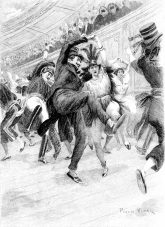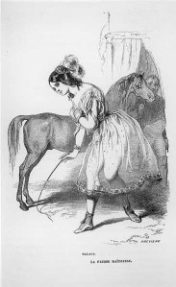
The Imaginary Mistress
THE HUMAN COMEDY – Honoré de Balzac First volume of works of Honoré de Balzac edited by widow André Houssiaux, publisher, Hebert and Co, successors, 7 rue Perronet – Paris (1877)
Scenes from private life

Clementine Laginska
LA FAUSSE MAITRESSE – “woman study”
Analysis of the work La Fausse Maîtresse is a slightly more authentic example of a “woman’s study”, although it is above all a “man’s study” whose origin is very different from the sketches Balzac could have conceived in 1832. The story was serialized in Le Siècle in December 1841, a few weeks before Balzac learned of Count Hanski’s death. There is therefore no reason to regard it as a parable in which Balzac sought to regain Madame Hanska’s favor after her decision not to prolong their affair. The Poles featured in this story have no significance other than as a courteous greeting to Madame Hanska, who could recognize in Thaddée Paz a portrait of one of her cousins she liked, Thaddée Wyleczynski. In fact, the situation that is the subject of the story had interested Balzac long before he knew Madame Hanska. It’s no more than a subject. Captain Thaddée Paz, in love with his friend’s wife and sensing that she’s going to love him, deliberately degrades himself in her eyes by pretending to have a debasing affair. Now, this love-court situation, whose central character is Captain Paz, of course, and not Countess Laginski, Balzac had noted in his album of subjects to be treated as early as 1831, and immediately drew from it one of the first Contes drolatiqueswhich he wrote at the time, Le Frère d’armes. In this first version, he had set the scene in a time that suited him better, the Valois court at the time of King Henri II. And the cruder subterfuge consisted in making people believe in an evil that the previous king’s companions claimed to have brought back from Italy. So it’s hardly a “woman’s study”, nor is it one of those “lessons” for women like the early Scènes de la vie privée. Nor is it an indispensable sign or simply characteristic of social description. It’s a very Balzacian story, however, with a particular aspect of sacrifice described. Thaddée Paz, in renouncing the happiness of possession, has not renounced all happiness. Witnessing another kind of happiness that doesn’t belong to him, he feels a secret joy in seeing the bright, happy life of this young couple for whom he has sacrificed himself. He has placed his own share of happiness on the heads of his friend and the woman he loves: he lives, not for another or for two others, but by another or by two others. He enjoys his happiness by delegation, as a kind of paternity, or rather as a refraction within himself of the happiness he has created. “He lives through me,” says his friend. That’s what Father Goriot says about his daughters, and what Vautrin says about Lucien de Rubempré in Splendeurs et misères des courtisanes. In this way, because she is a perfect example, a perfect example pure of this delegation of happiness, much purer than Vautrin’s, more disembodied than Goriot’s, The False Mistress is not a thin, overly romantic story, but a document of the human heart. 
History Short story published in the daily Le Siècle in December 1841. Captain Thaddée Paz, in love with his friend Adam’s wife and sensing that she is going to love him, voluntarily debases himself in her eyes by pretending to have a dishonorable affair. Thaddée Paz’s self-sacrifice and renunciation of the happiness of possession did not mean the renunciation of all joy. Witness to a happiness that does not belong to him, he feels a secret joy in seeing the bright, happy life of this young couple for whom he has sacrificed himself. He has placed his own share of happiness on the head of his friend and the woman he loves. He becomes the steward, the accountant, the servant of this family. He lives through these two people who are dear to him. Despite his devotion to the couple and to his dying friend, Thaddée, having so discredited himself with Countess Clementine Laginska, will never regain her esteem. He leaves the Hotel Laginska but continues, unbeknownst to Clémentine, to watch over her, saving her from a trap set by the Count de la Palférine. Clémentine hopes to see Thaddée again… her heart opens. La fausse maîtresse is an analysis of the human heart. Paris, January 1842
Genealogy of characters PAZ: Count Thaddée Paz, Polish exile in France. LAGINSKI: Count Adam Laginski, born around 1806, Polish exile in France. Married in 1835 Clémentine du Rouvre born in 1816. Allusion is made to Countess Laginska, Count Adam’s mother, who died in 1832. RUSTICOLI: Count Rusticoli de la Palférine, Italian noble family established in France, represented by : a count who, under Louis XV, entertained Mlle Laguerre (actress and owner of Les Aigues); a general who died in 1809 and married a Capponi ; Gabriel-Jean-Anne-Victor-Benjamin-Georges-Ferdinand-Charles-Edouard Rusticoli, comte de La Palférine, born 1812.
1) Source analysis/history: Preface compiled from the complete works of the Comédie Humaine (tome III) published by France Loisirs 1985 under the auspices of the Société des Amis d’Honoré de Balzac.
2) Character genealogy source: Félicien Marceau “Balzac et son monde” Gallimard.
No Comments